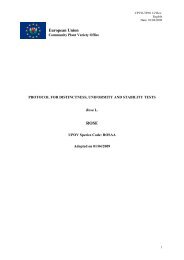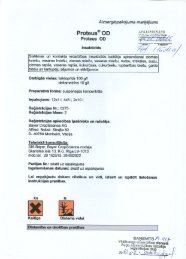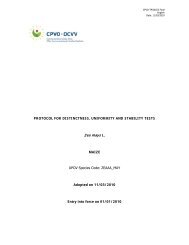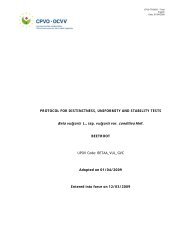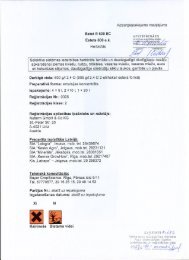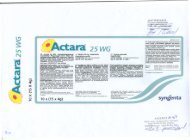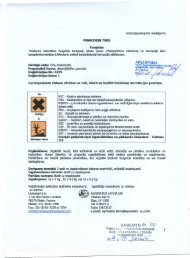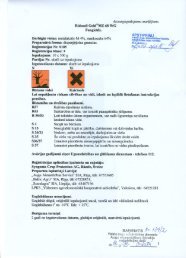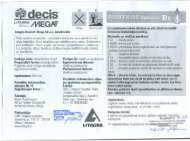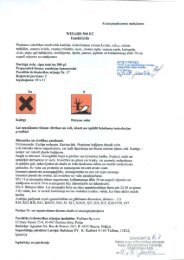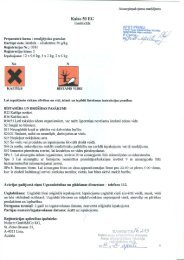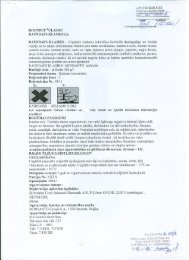Triticum aestivum L. - VAAD
Triticum aestivum L. - VAAD
Triticum aestivum L. - VAAD
Create successful ePaper yourself
Turn your PDF publications into a flip-book with our unique Google optimized e-Paper software.
CPVO-TP/003/4 Rev.2<br />
English<br />
Date: 16/02/2011<br />
PROTOCOL FOR DISTINCTNESS, UNIFORMITY AND STABILITY TESTS<br />
<strong>Triticum</strong> <strong>aestivum</strong> L.<br />
WHEAT<br />
UPOV Species Code: TRITI_AES<br />
Adopted on 16/02/2011<br />
Entry into force on 01/08/2010<br />
1
CPVO-TP/003/4 Rev.2<br />
English<br />
Date: 16/02/2011<br />
I<br />
SUBJECT OF THE PROTOCOL<br />
The protocol describes the technical procedures to be followed in order to meet the requirements of Council<br />
Regulation 2100/94 on Community Plant Variety Rights. The technical procedures have been agreed by the<br />
Administrative Council and are based on general UPOV Document TG/1/3 and UPOV Guideline TG/3/11 dated 4 th<br />
November 1994 for the conduct of tests for Distinctness, Uniformity and Stability. This protocol applies to all<br />
varieties of <strong>Triticum</strong> <strong>aestivum</strong> L.<br />
II<br />
SUBMISSION OF SEED AND OTHER PLANT MATERIAL<br />
1. The Community Plant Variety Office (CPVO) is responsible for informing the applicant of<br />
• the closing date for the receipt of plant material;<br />
• the minimum amount and quality of plant material required;<br />
• the Examination Office to which material is to be sent.<br />
A sub-sample of the material submitted for test will be held in the variety collection of the Examination Office<br />
as the definitive sample of the candidate variety.<br />
The applicant is responsible for ensuring compliance with any customs and plant health requirements.<br />
2. Final dates for receipt of documentation and material by the Examination Office<br />
The final dates for receipt of requests, technical questionnaires and the final date or submission period for<br />
plant material will be decided by the CPVO and each Examination Office chosen (hereunder point 3).<br />
The Examination Office is responsible for immediately acknowledging the receipt of requests for testing, and<br />
technical questionnaires. Immediately after the closing date for the receipt of plant material the Examination<br />
Office should inform the CPVO if no plant material has been received. However, if unsatisfactory plant material<br />
is submitted the CPVO should be informed as soon as possible.<br />
3. Seed requirements<br />
Information with respect to closing dates and submission requirements of plant material for the technical<br />
examination of varieties can be found on the CPVO web site (www.cpvo.europa.eu ) and in the special<br />
Issue S2 of the Official Gazette of the Office published yearly at the month of September.<br />
Quality of seed: ................. The minimum requirements for germination capacity, analytical purity and seed<br />
health should not be less than the standards laid down in EC Directive 66/402/EEC<br />
Seed Treatment: ................ The plant material must not have undergone any treatment unless the CPVO and<br />
the Examination Office allow or request such treatment. If it has been treated, full<br />
details of the treatment must be given.<br />
Labelling of sample: ........... - Species<br />
- File number of the application allocated by the CPVO<br />
- Breeder's reference<br />
- Examination Office reference (if known)<br />
- Name of applicant<br />
- The phrase “On request of the CPVO”.<br />
2
CPVO-TP/003/4 Rev.2<br />
English<br />
Date: 16/02/2011<br />
III<br />
CONDUCT OF TESTS<br />
1. Variety collection<br />
A variety collection will be maintained for the purpose of establishing distinctness of the candidate varieties in<br />
test. A variety collection may contain both living material and descriptive information. A variety will be included<br />
in a variety collection only if plant material is available to make a technical examination.<br />
Pursuant to Article 7 of Council Regulation No. 2100/94, the basis for a collection should be the following:<br />
• varieties listed or protected at the EU level or at least in one of the EEA Member States;<br />
• varieties protected in other UPOV Member States;<br />
• any other variety in common knowledge.<br />
• In case of hybrids, all components of hybrid varieties in common knowledge must be considered as part<br />
of the reference collection.<br />
The composition of the variety collection in each Examination Office depends on the ecological conditions in<br />
which the Examination Office is located.<br />
Variety collections will be held under conditions which ensure the long term maintenance of each accession. It<br />
is the responsibility of Examination Offices to replace reference material which has deteriorated or become<br />
depleted. Replacement material can only be introduced if appropriate tests confirm conformity with the<br />
existing reference material. If any difficulties arise for the replacement of reference material Examination<br />
Offices must inform the CPVO. If authentic plant material of a variety cannot be supplied to an Examination<br />
Office the variety will be removed from the variety collection.<br />
2. Material to be examined<br />
Candidate varieties will be directly compared with other candidates for Community plant variety rights tested<br />
at the same Examination Office, and with appropriate varieties in the variety collection. When necessary an<br />
Examination Office may also include other candidates and varieties. Examination Offices should therefore<br />
make efforts to co-ordinate the work with other offices involved in DUS-testing of wheat. There should be at<br />
least an exchange of technical questionnaires for each candidate variety, and during the test period,<br />
Examination Offices should notify each other and the CPVO of candidate varieties which are likely to present<br />
problems in establishing distinctness. In order to solve particular problems Examination Offices may exchange<br />
plant material.<br />
3. Characteristics to be used<br />
The characteristics to be used in DUS tests and preparation of descriptions shall be those referred to in the<br />
table of characteristics. All the characteristics shall be used, providing that observation of a characteristic is not<br />
rendered impossible by the expression of any other characteristic, or the expression of a characteristic is<br />
prevented by the environmental conditions under which the test is conducted. In the latter case, the CPVO<br />
should be informed. In addition the existence of some other regulation e.g. plant health, may make the<br />
observation of the characteristic impossible.<br />
The list of characteristics derived from electrophoresis as in Annex 3 should only be used as a complement to<br />
other differences in morphological or physiological characteristics.<br />
The Administrative Council empowers the President, in accordance with Article 23 of Commission Regulation<br />
N° 1239/95, to insert additional characteristics and their expressions in respect of a variety.<br />
3
CPVO-TP/003/4 Rev.2<br />
English<br />
Date: 16/02/2011<br />
4. Grouping of varieties<br />
The varieties and candidates to be compared will be divided into groups to facilitate the assessment of<br />
distinctness. Characteristics which are suitable for grouping purposes are those which are known from<br />
experience not to vary, or to vary only slightly, within a variety and which in their various states of expression<br />
are fairly evenly distributed throughout the collection. In the case of continuous grouping characteristics<br />
overlapping states of expression between adjacent groups is required to reduce the risks of incorrect allocation<br />
of candidates to groups. The characteristics that could be used for grouping are the following (CPVO<br />
numbering; G for grouping in table of characteristics)<br />
a) Straw: pith in cross section (characteristic 10)<br />
b) Awns or scurs: presence (characteristic 14)<br />
c) Ear: colour (characteristic 16)<br />
d) Seasonal type (characteristic 25)<br />
5. Trial designs and growing conditions<br />
The minimum duration of tests will normally be two independent growing cycles. Tests will be carried out<br />
under conditions ensuring normal growth. The size of the plots will be such that plants or parts of plants may<br />
be removed for measuring and counting without prejudice to the observations which must be made up to the<br />
end of the growing cycle.<br />
The test design is as follows:<br />
Each test should include about 2000 plants which should be divided between two or more replicates. The<br />
assessment for the characteristic ‘Seasonal type’ should be carried out on at least 500 plants.<br />
If ear rows are used, tests should be conducted on 100 ears.<br />
In case of hybrids, the parent lines have to be included in the test and should be tested and assessed as any<br />
other self-pollinating variety. The observations on the hybrid variety itself should be made on at least 200<br />
plants.<br />
All observations for the assessment of distinctness on individual plants should be made on 20 plants or parts of<br />
20 plants.<br />
6. Special tests<br />
In accordance with Article 83(3) of Council Regulation No. 2100/94 an applicant may claim either in the<br />
Technical Questionnaire or during the test that a candidate has a characteristic which would be helpful in<br />
establishing distinctness. If such a claim is made and is supported by reliable technical data, a special test may<br />
be undertaken providing that a technically acceptable test procedure can be devised.<br />
Special tests will be undertaken, with the agreement of the President of CPVO, where distinctness is unlikely to<br />
be shown using the characters listed in the protocol.<br />
7. Standards for decisions<br />
a) Distinctness<br />
A candidate variety will be considered to be distinct if it meets the requirements of Article 7 of Council<br />
Regulation No. 2100/94.<br />
4
CPVO-TP/003/4 Rev.2<br />
English<br />
Date: 16/02/2011<br />
To assess distinctness of hybrids, a pre-screening system on the basis of the parental lines and the<br />
formula may be established according to the following recommendations:<br />
(i) description of parental lines according to the Test Guidelines;<br />
(ii) check of the originality of the parental lines in comparison with the reference collection, based on the<br />
characteristics in the table of characteristics in order to screen the closest inbred lines;<br />
(iii) check of the originality of the hybrid formula in comparison with those of the hybrids in common<br />
knowledge, taking into account the closest inbred lines;<br />
(iv) assessment of the distinctness at the hybrid level of varieties with a similar formula.<br />
Qualitative characteristics:<br />
In the case of characteristics which show discrete discontinuous states of expression, a difference between<br />
two varieties is clear if the respective characteristics have expressions which fall into two different states.<br />
Quantitative characteristics:<br />
Characteristics which show a continuous range of expression from one extreme to the other may be either<br />
measured or visually observed.<br />
In the case of visually observed characteristics, a difference between two varieties is clear if the expression of<br />
the respective characteristics differs by at least the span of one note, taking into account the variability<br />
observed within the varieties.<br />
If distinctness is assessed using the t-test least significant difference the difference between two varieties is<br />
clear if it occurs with the same sign at the 1% significance level or less (p
CPVO-TP/003/4 Rev.2<br />
English<br />
Date: 16/02/2011<br />
Characteristics which should be observed on a sample size of 100 plants are indicated by an “A” in the table of<br />
characteristics. For these “A” characteristics, with the exception of characteristics 1 and 24, the assessment of<br />
uniformity can be done in 2 steps. In a first step, 20 plants or parts of plants are observed. If no off-types are<br />
observed, the variety is declared to be uniform. If more than 3 off-types are observed, the variety is declared<br />
not to be uniform. If 1 to 3 off-types are observed, an additional sample of 80 plants or parts of plants must<br />
be observed.<br />
With respect to the use of enzyme electrophoresis, the Office follows the actual UPOV approach as laid<br />
down in part I of Annex 3 hereto. If electrophoresis is used for testing distinctness, the same population<br />
standard and the same acceptance probability as for other characteristics should be applied. However, a<br />
sequential analysis approach could be applied to reduce the workload.<br />
Electrophoresis characteristics with a lack of uniformity shall not be taken into account for the assessment<br />
of distinctness.<br />
c) Stability<br />
A candidate will be considered to be sufficiently stable when there is no evidence to indicate that it lacks<br />
uniformity.<br />
Seed samples of further submissions included in any test must show the same expression of characteristics as<br />
the material originally supplied.<br />
IV<br />
REPORTING OF RESULTS<br />
After each recording season the results will be summarised and reported to the CPVO in the form of a UPOV model<br />
interim report in which any problems will be indicated under the headings distinctness, uniformity and stability.<br />
Candidates may meet the DUS standards after two growing cycles but in some cases three growing cycles may be<br />
required. When tests are completed the results will be sent by the Examination Office to the CPVO in the form of a<br />
UPOV model final report.<br />
If it is considered that the candidate complies with the DUS standards, the final report will be accompanied by a<br />
variety description in the format recommended by UPOV. If not the reasons for failure and a summary of the test<br />
results will be included with the final report.<br />
The CPVO must receive interim reports and final reports by the date agreed between the CPVO and the Examination<br />
Office.<br />
Interim reports and final examination reports shall be signed by the responsible member of the staff of the<br />
Examination Office and shall expressly acknowledge the exclusive rights of disposal of CPVO.<br />
V<br />
LIAISON WITH THE APPLICANT<br />
If problems arise during the course of the test the CPVO should be informed so that the information can be passed<br />
on to the applicant. Subject to prior permanent agreement, the applicant may be directly informed at the same time<br />
as the CPVO particularly if a visit to the trial is advisable.<br />
6
CPVO-TP/003/4 Rev.2<br />
English<br />
Date: 16/02/2011<br />
VI<br />
ENTRY INTO FORCE<br />
The present protocol enters into force on 01.08.2010. Any ongoing DUS examination of candidate varieties<br />
started before the aforesaid date will not be affected by the approval of the partially revised Technical Protocol.<br />
Technical examinations of candidate varieties are carried out according to the TP in force when the DUS test<br />
starts. The starting date of a DUS examination is considered to be the due date for submitting of plant material<br />
for the first test period.<br />
In cases where the Office requests to take-over a DUS report for which the technical examination has either<br />
been finalized or which is in the process to be carried out at the moment of this request, such report can only<br />
be accepted if the technical examination has been carried out according to the CPVO TP which was in force at<br />
the moment when the technical examination started.<br />
**********<br />
7
CPVO-TP/003/4 Rev.2<br />
English<br />
Date: 16/02/2011<br />
VI<br />
TABLE OF CHARACTERISTICS TO BE USED IN DUS-TEST AND PREPARATION OF<br />
DESCRIPTION<br />
CPVO<br />
N°<br />
UPOV<br />
N°<br />
Characteristics Stage, 1<br />
Method<br />
Examples 2<br />
Note<br />
1. 1. Coleoptile: anthocyanin coloration 09-11<br />
(+) 3 absent or very weak A; VG Herzog; Delos 1<br />
weak Niklas; Baldus 3<br />
medium Andros; Planet 5<br />
strong Obelisk; Briscard 7<br />
very strong Albatros; - 9<br />
2. 2. Plant: growth habit 25-29<br />
(+) erect B; VG Castan; - 1<br />
semi-erect Frandoc; Remus 3<br />
intermediate Obelisk; Troll 5<br />
semi-prostrate Boss; - 7<br />
prostrate Beaver; - 9<br />
3. 4. Plant: frequency of plants with<br />
recurved flag leaves<br />
47-51<br />
(+) absent or very low B; VG Apollo 1<br />
low Recital; Axona 3<br />
medium Obelisk; Filou 5<br />
high Frandoc; Prinqual 7<br />
very high Capitole; - 9<br />
1<br />
2<br />
3<br />
The optimum stage of development as well as method of observation for the assessment of each characteristic are indicated by<br />
numbers and letters. Explanations are given in Annex 1 in ‘Explanations and Methods’.<br />
Example varieties, separated by a semicolon, are indicated for winter wheat before the semicolon, for spring wheat they follow the<br />
semicolon. Example varieties are given as an indication, others may be used.<br />
See explanations in Annex 1 in ‘Explanations and Methods’.<br />
8
CPVO-TP/003/4 Rev.2<br />
English<br />
Date: 16/02/2011<br />
CPVO<br />
N°<br />
UPOV<br />
N°<br />
Characteristics Stage, 1<br />
Method<br />
Examples 2<br />
Note<br />
4. 5. Time of ear emergence<br />
(first spikelet visible on 50% of<br />
ears)<br />
50-52<br />
very early B; MG Britta; Florence Aurore 1<br />
early Recital; Remus 3<br />
medium Astron; Paros 5<br />
late Moulin; Vitus 7<br />
very late Beaver; - 9<br />
5. 6. Flag leaf: glaucosity of sheath 60-65<br />
(+) absent or very weak B; VG Cargo; Adonis 1<br />
weak Heiduck; Ventura 3<br />
medium Agent; Hanno 5<br />
strong Orestis; Prinqual 7<br />
very strong Haven; Wim 9<br />
6. Flag leaf: glaucosity of blade<br />
(lower side)<br />
60-65<br />
absent or very weak A; VG Shamrock; - 1<br />
weak Valoris; Josselin 3<br />
medium Pauillac; Tecnico 5<br />
strong Cezanne; Torka 7<br />
very strong Charger; 9<br />
7. 7. Ear: glaucosity 60-69<br />
absent or very weak B; VG Soissons; Adonis 1<br />
weak Garant; Ventura 3<br />
medium Contra; Paros 5<br />
strong Niklas; Combi 7<br />
very strong Boxer; Wim 9<br />
9
CPVO-TP/003/4 Rev.2<br />
English<br />
Date: 16/02/2011<br />
CPVO<br />
N°<br />
UPOV<br />
N°<br />
Characteristics Stage, 1<br />
Method<br />
Examples 2<br />
Note<br />
8. 8. Culm: glaucosity of neck 60-69<br />
absent or very weak B; VG Goelent; Adonis 1<br />
weak Soissons; Ventura 3<br />
medium Haven; Attis 5<br />
strong Herzog; Nandu 7<br />
very strong Quotador; Wim 9<br />
9. 9. Plant: length (stem, ear, awns and<br />
scurs)<br />
75-92<br />
very short B; MG Courtot; Briscard 1<br />
short Konsul; Remus 3<br />
medium Sideral; Ventura 5<br />
long Boxer; Adonis 7<br />
very long Aladin; Vitus 9<br />
10. 10. Straw: pith in cross section<br />
(halfway between base of ear and<br />
stem node below)<br />
80-92<br />
(+) absent or very thin A; VG Boregar; SW Kadrilj 1<br />
medium Provinciale; Tybalt 2<br />
G very thick or filled Camp Remy; Azurite 3<br />
11. 11. Ear: shape in profile 92<br />
(+) tapering A; VG Slejpner; Filou 1<br />
parallel sided -; - 2<br />
semi-clavate Pane 247; - 3<br />
clavate Beauchamp; Prinqual 4<br />
fusiform Declic; Nandu 5<br />
10
CPVO-TP/003/4 Rev.2<br />
English<br />
Date: 16/02/2011<br />
CPVO<br />
N°<br />
UPOV<br />
N°<br />
Characteristics Stage, 1<br />
Method<br />
Examples 2<br />
Note<br />
12. 12. Ear: density 80-92<br />
(+) very lax A; VG Demar 4; - 1<br />
lax Castan; Ventura 3<br />
medium Soissons; Hanno 5<br />
dense Forby; Combi 7<br />
very dense -; - 9<br />
13. 13. Ear: length (excluding awns and<br />
scurs)<br />
80-92<br />
(+) very short A; MS -; - 1<br />
short Carat; - 3<br />
medium Ritmo; Arkas 5<br />
long Forby; Prinqual 7<br />
very long Amifort; - 9<br />
14. 14. Awns or scurs: presence 80-92<br />
(+) both absent B; VG Futur; Axona 1<br />
scurs present Festival; Furio 2<br />
G awns present Soissons; Ventura 3<br />
15. 15. Awns or scurs at tip of ear: length 80-92<br />
very short B; MS Herzog; - 1<br />
short Andros; Combi 3<br />
medium Pagode; Hanno 5<br />
long Fidel; - 7<br />
very long Gaucho; - 9<br />
16. 16. Ear: colour 80-92<br />
white B; VG Herzog; Furio 1<br />
G coloured Gallo; Prinqual 2<br />
11
CPVO-TP/003/4 Rev.2<br />
English<br />
Date: 16/02/2011<br />
CPVO<br />
N°<br />
UPOV<br />
N°<br />
Characteristics Stage, 1<br />
Method<br />
Examples 2<br />
Note<br />
17. 17. Apical rachis segment: hairiness of<br />
convex surface<br />
80-92<br />
(+) absent or very weak A; VG Soissons; - 1<br />
weak Slejpner; Furio 3<br />
medium Beaver; Rock 5<br />
strong Apollo; Axona 7<br />
very strong Carat; - 9<br />
18. 18. Lower glume: shoulder width<br />
(spikelet in midthird of ear)<br />
80-92<br />
(+) absent or very narrow A; VG Courtot; - 1<br />
narrow Soissons; Wim 3<br />
medium Sideral; Furio 5<br />
broad Castan; Filou 7<br />
very broad Abo 9<br />
19. 19. Lower glume: shoulder shape<br />
(as for 18)<br />
80-92<br />
(+) sloping A; VG Courtot; - 1<br />
slightly sloping Forby; Ventura 3<br />
straight Herzog; Prinqual 5<br />
elevated Beaver; Adonis 7<br />
strongly elevated with 2nd point<br />
present<br />
Farnese; - 9<br />
20. 20. Lower glume: beak length (as for<br />
18)<br />
80-92<br />
very short A; VG Aladin; Sunnan 1<br />
short Sideral; Axona 3<br />
medium Recital; Furio 5<br />
long Soissons; Tejo 7<br />
very long Courtot; Prinqual 9<br />
12
CPVO-TP/003/4 Rev.2<br />
English<br />
Date: 16/02/2011<br />
CPVO<br />
N°<br />
UPOV<br />
N°<br />
Characteristics Stage, 1<br />
Method<br />
Examples 2<br />
Note<br />
21. 21. Lower glume: beak shape (as for 18) 80-92<br />
(+) straight A; VG Festival; Lobo 1<br />
slightly curved Slejpner; Furio 3<br />
moderately curved Courtot; Rock 5<br />
strongly curved Arum; - 7<br />
geniculate -; - 9<br />
22. 22. Lower glume: extent of internal hair<br />
(as for 18)<br />
80-92<br />
(+) weak A; VG Slejpner; Prinqual 3<br />
medium Sideral; Furio 5<br />
strong Declic; Tejo 7<br />
23. 24. Grain: colour 92<br />
white A; VG Recital; Florence Aurore 1<br />
red Soissons; Ventura 2<br />
24. 25. Grain: coloration with phenol 92<br />
(+) none or very light A; VG -; - 1<br />
light Soissons; - 3<br />
medium Orestis; Prinqual 5<br />
dark Slejpner; Rock 7<br />
very dark Sideral; Ventura 9<br />
25. 26. Seasonal type -<br />
(+) winter type B; VG Slejpner; - 1<br />
alternative type Fidel; - 2<br />
G spring type -; Nandu 3<br />
13
CPVO-TP/003/4 Rev.2<br />
English<br />
Date: 16/02/2011<br />
ANNEXES TO FOLLOW<br />
ANNEX I<br />
PAGE<br />
Explanations and methods .............................................................................................................. 15<br />
Decimal code for growth stages .............................................................................................. 20<br />
ANNEX II<br />
Electrophoresis .............................................................................................................................. 23<br />
ANNEX III<br />
Technical Questionnaire<br />
14
CPVO-TP/003/4 Rev.2<br />
English<br />
Date: 16/02/2011<br />
ANNEX I<br />
EXPLANATIONS AND METHODS<br />
Method of observation of characteristics<br />
Letters indicate the relevant method for the assessment of uniformity and distinctness<br />
A<br />
B<br />
Sample size of 100 plants to be observed for the assessment of uniformity<br />
Sample size of appr. 2000 plants to be observed in a plot for the assessment of uniformity<br />
MG<br />
Single measurement of a group of plants or parts of plants for the assessment of distinctness<br />
MS<br />
VG<br />
VS<br />
Measurement of a number of individual plants or parts of plants for the assessment of distinctness<br />
Visual assessment by a single observation of a group of plants or parts of plants for the assessment of<br />
distinctness<br />
Visual assessment by observation of individual plants or parts of plants for the assessment of<br />
distinctness<br />
How to apply the above mentioned assessment methods in practice:<br />
1. Assessment of uniformity<br />
When attributing the letter A or B for the assessment of uniformity of a certain characteristic, the expert should address<br />
himself to single plants (A) or to all plants of the plot (B). The population standards as defined for observations made on<br />
either A or B need to be applied accordingly.<br />
2. Assessment of distinctness<br />
When a method of observation is attributed to a certain characteristic, the first differentiation is made depending if the<br />
action taken is a visual observation (V) or a measurement (M).<br />
The second differentiation deals with the number of observations the expert attributes to each variety, thus the<br />
attribution of either G or S.<br />
If a single observation of a group consisting of an undefined number of individual plants is appropriate to assess the<br />
expression of a variety, we talk about a visual observation or a measurement made on a group of plants, thus we<br />
attribute the letter G (either VG or MG). If the expert makes more than one observation on that group of plants, the<br />
decisive part is that we have at the end only one data entry per variety which means that we have to deal with G (e.g.<br />
measurement of plant length on a plot – MG, visual observation of green colour of leaves on a plot – VG).<br />
If it is necessary to observe a number of individual plants to assess the expression of a variety, we should attribute the<br />
letter S (thus either VS or MS). Single plant data entries are kept per variety for further calculations like the variety mean<br />
(e.g. measurement of length of ears – MS, visual observation of growth habit of single plants in grasses – VS). The<br />
number of individual plants to be observed in such cases is stated in section III.5.<br />
15
CPVO-TP/003/4 Rev.2<br />
English<br />
Date: 16/02/2011<br />
Ad 1: Coleoptile: anthocyanin coloration<br />
Number of grains per test ..................... 100 grains<br />
Method for the Determination of Anthocyanin Coloration<br />
Preparation of grains ............................ Set up non-dormant grains on moistened filter paper covered with a Petri dish<br />
lid during germination.<br />
Place .................................................. Laboratory or greenhouse.<br />
Light ................................................... After the coleoptiles have reached a length of about 1 cm in darkness, they are<br />
placed in artificial light (daylight equivalent), at 15,000 lux continuously for 3 -<br />
4 days.<br />
Temperature ....................................... 15 to 20°C.<br />
Time of recording ................................ Coleoptiles fully developed (about 1 week) at stage 09-11.<br />
Scale of recording ................................ See characteristic 1.<br />
Note ................................................... At least two of the example varieties should be included as a control when<br />
testing for distinctness.<br />
Ad 2: Plant: growth habit<br />
1 erect<br />
3 semi-erect<br />
5 intermediate<br />
7 semi-prostrate<br />
9 prostrate<br />
The growth habit should be assessed visually from the attitude of the leaves and tillers. The angle formed by the outer<br />
leaves and the tillers with an imaginary vertical axis should be used.<br />
Ad 3: Plant: frequency of plants with recurved flag leaves<br />
1. ......... all flag leaves are rectilinear<br />
3. ......... about 1/4 of the plants with recurved flag leaves<br />
5. ......... about 1/2 of the plants with recurved flag leaves<br />
7. ......... about 3/4 of the plants with recurved flag leaves<br />
9. ......... all flag leaves are recurved<br />
Ad 5: Flag leaf: glucosity of sheath<br />
The strongest expression on the sheath should be observed.<br />
16
CPVO-TP/003/4 Rev.2<br />
English<br />
Date: 16/02/2011<br />
Ad 10: Straw: pith in cross section (half way between base of ear and stem node below)<br />
All stems of the plant should be checked and the strongest expression per plant recorded.<br />
1 2 3<br />
absent or very thin medium very thick or filled<br />
Ad 11: Ear: shape in profile<br />
1 2 3 4 5<br />
tapering parallel-sided semi-clavate clavate fusiform<br />
Ad 12: Ear: density<br />
The density can be assessed either visually or as measurement of the ratio of the number of spikelets/ear length.<br />
Ad 13: Ear: length (excluding awns and scurs)<br />
Single ear of the main stem to be measured.<br />
Ad 14: Awns or scurs: presence<br />
1 2 3<br />
both absent scurs present awns present<br />
17
CPVO-TP/003/4 Rev.2<br />
English<br />
Date: 16/02/2011<br />
Ad 17: Apical rachis segment: hairiness of convex surface<br />
1 3 5 7 9<br />
absent or very weak weak medium strong very strong<br />
Ad 18: Lower glume: shoulder width (spikelet in mid-third of ear)<br />
1 3 5 7 9<br />
absent or very narrow narrow medium broad very broad<br />
Ad 19: Lower glume: shoulder shape (spikelet in mid-third of ear)<br />
1 3 5 7 9<br />
sloping slightly sloping straight elevated strongly elevated<br />
with 2nd point present<br />
Ad 21: Lower glume: beak shape (spikelet in mid-third of ear)<br />
1 3 5 7 9<br />
straight slightly curved moderately curved strongly curved geniculate<br />
18
CPVO-TP/003/4 Rev.2<br />
English<br />
Date: 16/02/2011<br />
Ad 22: Lower glume: extent of internal hairs (spikelet in mid-third of ear)<br />
3 5 7<br />
weak medium strong<br />
Ad 24: Grain: coloration with phenol<br />
Method for Determination of Phenol Reaction<br />
Number of grains per test ............................. 100 grains. The grains should not have been treated chemically<br />
Preparation of grains .................................... Soak in tap water for 16 to 20 hours, drain and remove surface water,<br />
place the grains with crease downwards, cover dish with lid<br />
Concentration of solution .............................. 1 per cent Phenol-solution (freshly made up)<br />
Amount of solution ....................................... The grains should be about 3/4 covered<br />
Place .......................................................... Laboratory<br />
Light ........................................................... Daylight - out of direct sunshine<br />
Temperature ............................................... 18 to 20°C<br />
Time of recording ........................................ 4 hours (after adding solution)<br />
Scale of recording ........................................ See characteristic 25 in the Table of Characteristics<br />
Note ........................................................... At least two of the example varieties should be included as a control<br />
Ad 25: Seasonal type<br />
The seasonal type should be assessed on one or several plots sown in springtime. Example varieties should always be<br />
included in the plots. When the example varieties behave according to this description, the varieties under study can be<br />
described. At the time when the latest spring type variety is fully mature (stage 91/92 of the Eucarpia decimal code), the<br />
growth stage reached by the respective variety should be assessed. The states of expression are defined as follows:<br />
Winter type: .................................................. The plants have reached stage 45 of the Eucarpia decimal code (boots<br />
swollen) at maximum.<br />
Alternative type: ............................................ The plants have exceeded stage 45 of the Eucarpia decimal code---as a<br />
rule they have exceeded stage 75---and have reached stage 90 at<br />
maximum.<br />
Spring type: .................................................. The plants have exceeded stage 90 of the Eucarpia decimal code.<br />
19
CPVO-TP/003/4 Rev.2<br />
English<br />
Date: 16/02/2011<br />
DECIMAL CODE FOR THE GROWTH STAGE 4<br />
2- digit Code General description Feekes’ Scale<br />
Germination<br />
00 Dry seed<br />
01 Start of imbibition<br />
02 -<br />
03 Imbibition complete<br />
04 -<br />
05 Radicle emerged from caryopsis<br />
06 -<br />
07 Coleoptile emerged from caryopsis<br />
08 -<br />
09 Leaf just at coleoptile tip<br />
Additional remarks on Wheat,<br />
Barley, Rye, Oats and Rice<br />
Seedling growth<br />
10 First leaf through coleoptile<br />
11 First leaf unfolded (1)<br />
12 2 leaves unfolded<br />
13 3 leaves unfolded<br />
14 4 leaves unfolded<br />
15 5 leaves unfolded<br />
16 6 leaves unfolded<br />
17 7 leaves unfolded<br />
18 8 leaves unfolded<br />
19 9 or more leaves unfolded<br />
1 - Second leaf visible (less than 1 cm)<br />
50% of laminae unfolded<br />
Tillering<br />
20 Main shoot only<br />
21 Main shoot and 1 tiller 2 This section to be used to<br />
22 Main shoot and 2 tillers<br />
23 Main shoot and 3 tillers<br />
24 Main shoot and 4 tillers<br />
25 Main shoot and 5 tillers<br />
26 Main shoot and 6 tillers<br />
27 Main shoot and 7 tillers<br />
28 Main shoot and 8 tillers<br />
29 Main shoot and 9 or more tillers<br />
3<br />
supplement records from other<br />
sections of the table: “Concurrent<br />
codes”.<br />
Stem elongation<br />
Pseudo stem erection (2) 4-5 In rice: vegetative lag phase<br />
30<br />
31 1 st node detectable 6<br />
32 2 nd node detectable 7<br />
33 3 rd node detectable<br />
34 4 th node detectable<br />
35 5 th node detectable<br />
36 6 th node detectable<br />
37 Flag leaf just visible 8<br />
Jointing stage<br />
Above crown nodes<br />
38 - Pre-boot stage<br />
39 Flag leaf ligule / collar just visible 9<br />
In rice: Opposite auricle<br />
4 Reproduced from EUCARPIA Bulletin No. 7, 1974, pp.49 - 52, with the kind permission of the authors. For further information, see J.C. Zadoks,<br />
T.T. Chang and C.F. Konzak, EUCARPIA Bulletin No. 7, 1974, pp. 42 - 52. The French translation has been kindly furnished by Mrs. R. Cassini,<br />
Mr. R. Cassini and Mr. R. Marie. The German translation has been kindly furnished by Mr. A.O. Klomp and Mrs. I. Volk.<br />
20
CPVO-TP/003/4 Rev.2<br />
English<br />
Date: 16/02/2011<br />
2- digit Code General description Feekes’ Scale<br />
Additional remarks on Wheat,<br />
Barley, Rye, Oats and Rice<br />
40<br />
Booting<br />
-<br />
Little enlargement of the<br />
inflorescence, early-boot stage<br />
41 Flag leaf sheath extending<br />
42 -<br />
43 Boots just visibly swollen<br />
Mid-boot stage<br />
44 -<br />
10<br />
45 Boots swollen Late-boot stage<br />
46 -<br />
47 Flag leaf sheath opening<br />
48 -<br />
49 First awns visible 10.1 In awned forms only<br />
50<br />
Inflorescence emergence<br />
First spikelet of inflorescence just N<br />
51 visible<br />
S<br />
52 1/4 of inflorescence emerged N 10.2 N = non-synchronous crops<br />
53 S S = synchronous crops<br />
54 1/2 of inflorescence emerged N 10.3<br />
55 S<br />
56 3/4 of inflorescence emerged N 10.4<br />
57 S<br />
58 Emergence of inflorescence<br />
N 10.5<br />
59 completed<br />
S<br />
60<br />
Anthesis<br />
Beginning of anthesis N 10.51 Not easily detectable in barley.<br />
61 S<br />
In rice: usually immediately<br />
62 -<br />
following heading<br />
63 -<br />
64 Anthesis half-way N 10.52<br />
65 S<br />
66 -<br />
67 -<br />
68 Anthesis complete N 10.53<br />
69 S<br />
Milk development<br />
70 -<br />
71 Caryopsis watery ripe 10.54<br />
72 -<br />
73 Early milk<br />
74 - 11.1<br />
75 medium milk<br />
76 -<br />
77 Late milk<br />
78 -<br />
79 -<br />
Increase in solids of liquid<br />
endosperm notable when<br />
crushing the caryopsis between<br />
fingers.<br />
Dough development<br />
80 -<br />
81 -<br />
82 -<br />
83 Early dough<br />
84 -<br />
85 Soft dough 11.2<br />
86 -<br />
87 Hard dough<br />
88 -<br />
89 -<br />
Fingernail impression not held.<br />
Fingernail impression held,<br />
inflorescence losing chlorophyll.<br />
21
CPVO-TP/003/4 Rev.2<br />
English<br />
Date: 16/02/2011<br />
2- digit Code General description Feekes’ Scale<br />
Additional remarks on Wheat,<br />
Barley, Rye, Oats and Rice<br />
90<br />
Ripening<br />
- In rice: terminal spikelets ripened.<br />
91 Caryopsis hard (difficult to divide by<br />
11.3<br />
thumb-nail) (3)<br />
92 Caryopsis hard (can no longer be<br />
11.4 In rice: 50% of spikelets ripened<br />
dented by thumb-nail) (4)<br />
93 Caryopsis loosening in daytime In rice: over 90% of spikelets<br />
94 Over-ripe, straw dead and<br />
collapsing<br />
ripened<br />
95 Seed dormant Risk of grain loss by shedding<br />
96 Viable seed giving 50% germination<br />
97 Seed not dormant<br />
98 Secondary dormancy induced<br />
99 Secondary dormancy lost<br />
T1<br />
Transplanting and recovery (rice<br />
only)<br />
Uprooting of seedlings<br />
T2 -<br />
T3 Rooting<br />
T4 -<br />
T5 -<br />
T6 -<br />
T7 Recovery of shoots<br />
T8 -<br />
T9 Resumption of vegetative growth<br />
Notes on the Table of the Decimal Code for the Growth Stages or Cereals<br />
(1) Stage of seedling inoculation with rust in the greenhouse.<br />
(2) Only applicable to cereals with a prostrate or semi-prostrate early growth habit.<br />
(3) Ripeness for binder (ca. 16% water content). Chlorophyll of inflorescence largely lost.<br />
(4) Ripeness for combine harvester (less than 16% water content).<br />
(5) Optimum harvest time.<br />
22
CPVO-TP/003/4 Rev.2<br />
English<br />
Date: 16/02/2011<br />
ANNEX II<br />
ELECTROPHORESIS<br />
Additional Useful Explanations<br />
TABLE OF CONTENTS<br />
PAGE<br />
Part I Introduction ......................................................................................................... 24<br />
Part II Characteristics derived by using electrophoresis ...................................................... 25<br />
Part III Description of the method to be used ..................................................................... 26<br />
23
CPVO-TP/003/4 Rev.2<br />
English<br />
Date: 16/02/2011<br />
Part I<br />
Introduction<br />
The following Annex contains a list of characteristics derived by using electrophoresis and a description of the method to<br />
be used. UPOV decided to place these characteristics in an Annex to the Test Guidelines, thereby creating a special<br />
category of characteristic, because the majority of the UPOV member States is of the view that it is not possible to<br />
establish distinctness solely on the basis of a difference found in a characteristic derived by using electrophoresis. Such<br />
characteristics should therefore only be used as a complement to other differences in morphological or physiological<br />
characteristics. UPOV has reconfirmed that these characteristics are considered useful but that they might not be<br />
sufficient on their own to establish distinctness. They should not be used as a routine characteristic but at the request or<br />
with the agreement of the applicant of the candidate variety.<br />
For the analysis of high molecular weight (HMW) glutenins, polyacrylamide gel electrophoresis in the presence of sodium<br />
dodecyl sulphate (SDS PAGE) should be used. Glutenins are encoded by three compound loci, known as Glu-A1, Glu-B1<br />
and Glu-D1 on the long arms of the group 1 chromosomes (Payne, 1987). There are a number of alleles at each locus<br />
and the analysis of HMW glutenins is based on the recognition of these alleles from proteins, which appear on gels as a<br />
series of well-defined bands or patterns of bands. The alleles are described by band numbers according to the definition<br />
given to them by Payne and Lawrence, 1983 (see Chapter IX, Literature). The corresponding letters and apparent<br />
molecular weights are reproduced in the description of the method used.<br />
24
CPVO-TP/003/4 Rev.2<br />
English<br />
Date: 16/02/2011<br />
Part II<br />
Characteristics Derived by Using Electrophoresis<br />
Characteristics Stage 1) Example Varieties Note<br />
27.<br />
(+)<br />
Glutenin composition:<br />
allele expression at locus Glu-A1<br />
band 1 Kadett 1<br />
band 2* Courtot 2<br />
no band Talent 3<br />
28.<br />
(+)<br />
Glutenin composition:<br />
allele expression at locus Glu-B1<br />
bands 6 + 8 Norman 1<br />
bands 7 + 8 Courtot 2<br />
bands 7 + 9 Kadett 3<br />
band 7 (or 7 + 9 in the<br />
presence of bands 5 + 10 of<br />
char. 29)<br />
Okapi 4<br />
bands 13 + 16 Carala 5<br />
bands 14 + 15 Troll 6<br />
bands 17 + 18 Moulin 7<br />
band 20 Figaro 8<br />
bands 6.1 + 22 Schwabenkorn 9<br />
29.<br />
(+)<br />
Glutenin composition: allele<br />
expression at locus Glu-D1<br />
bands 2 + 12 Courtot 1<br />
bands 3 + 12 Norman 2<br />
bands 4 + 12 Talent 3<br />
bands 5 + 10 Kadett 4<br />
25
CPVO-TP/003/4 Rev.2<br />
English<br />
Date: 16/02/2011<br />
1. Apparatus and equipment<br />
Part III<br />
Description of the Method to be Used<br />
Glutenin composition: allele expression at loci Glu-A1 (27), Glu-B1 (28) and Glu-D1 (29)<br />
SDS PAGE Method for Analysis of HMW Glutenins from T. <strong>aestivum</strong><br />
Any suitable vertical electrophoresis system can be used, provided that the gels can be kept at a constant temperature.<br />
A gel thickness of no more than 1.5 mm is recommended. The power supply used should be capable of delivering both<br />
constant current and constant voltage output.<br />
2. Chemicals<br />
All chemicals should be of 'Analytical Reagent' grade or better.<br />
Acrylamide (specially purified for electrophoresis)<br />
Bisacrylamide (specially purified for electrophoresis)<br />
Tris (hydroxymethyl) methylamine (TRIS)<br />
Sodium dodecyl sulphate (SDS)<br />
Ammonium persulphate (APS)<br />
2-mercaptoethanol<br />
TEMED (NNN'N'-tetramethylethylenediamine)<br />
Trichloroacetic acid (TCA)<br />
Hydrochloric acid<br />
Glacial acetic acid<br />
Glycine<br />
n-Butanol<br />
Pyronin Y (or G)<br />
Glycerol (d = 1.256)<br />
Methanol or ethanol<br />
Coomassie Brilliant Blue R-250 (or equivalent)<br />
Coomassie Brilliant Blue G-250 (or equivalent)<br />
3. Solutions<br />
3.1 Extraction solution<br />
3.1.1 Extraction of glutenins only<br />
Stock solution:<br />
6.25 ml 1M TRIS HCl buffer, PH 6.8 (see 3.3.2)<br />
12.05 ml distilled water<br />
2g SDS<br />
10 mg Pyronin Y (or G)<br />
10 ml glycerol<br />
This solution can be stored for two months at 4°C.<br />
Immediately before use, extraction solution is prepared as follows:<br />
4.25 ml stock solution (above) plus 0.75 ml 2-mercaptoethanol made up to 10.0 ml with distilled water. This solution<br />
must be prepared immediately prior to use and cannot be stored.<br />
3.1.2 Extraction of glutenins following gliadins<br />
Solution A - 25 ml 2 - chloroethanol + 50 mg Pyronin Y/G, made up to 100 ml with distilled water.<br />
Solution B - 27.0 g urea, 3.0 ml 2 - mercaptoethanol + 10.0 g SDS, made up to 100 ml with distilled water.<br />
26
CPVO-TP/003/4 Rev.2<br />
English<br />
Date: 16/02/2011<br />
3.2 Electrophoresis (running) buffer<br />
Stock solution:<br />
141.1 g glycine<br />
30.0 g TRIS<br />
10.0 g SDS<br />
made up to 1 with distilled water.<br />
Immediately before use, the stock solution is diluted 1:10 with distilled water.<br />
The stock buffer solution can be stored for 2 months at room temperature. Do not store the diluted buffer more than<br />
one week. The pH of the buffer must be close to 8.3.<br />
3.3 Gel preparation solutions<br />
3.3.1 Stock resolving gel buffer (1M TRIS HCl, pH 8.8)<br />
121.14 g TRIS plus approximately 20 ml HCl (d = 1.19) made up to 1 l with distilled water. This buffer can be<br />
stored at 4°C for 2 months.<br />
3.3.2 Stock stacking gel buffer (1M TRIS HCl, pH 6.8)<br />
121.14 g TRIS plus approximately 78 ml HC1 (d = 1.19) made up to 1 l with distilled water. This buffer can be<br />
stored at 4°C for 2 months.<br />
3.3.3 10% (w/v) SDS solution<br />
10g of SDS dissolved in distilled water and made up to 100 ml. This solution can be stored at 4°C for 2 months.<br />
Prior to use, stir and heat gently to re-dissolve the SDS, if it comes out of solution.<br />
3.3.4 1% (w/v) ammonium persulphate solution<br />
1g of APS dissolved in distilled water and made up to 100 ml. This solution must be prepared immediately prior to<br />
use.<br />
3.3.5 Stock acrylamide solution<br />
40.02g acrylamide made up to 100 ml with distilled water.<br />
3.3.6 Stock bisacrylamide solution<br />
0.5198g bisacrylamide made up to 130 ml with distilled water.<br />
3.4 Staining solutions<br />
3.4.1 0.25g Coomassie Brilliant Blue G-250 plus 0.75g Coomassie Brilliant Blue R-250, made up to 100 ml with water.<br />
3.4.2 55g TCA, 65 ml glacial acetic acid, 180 ml methanol or ethanol plus 25 ml solution 3.4.1, made up to 11 with<br />
distilled water.<br />
4. Procedure<br />
4.1 Protein extraction<br />
4.1.1 Glutenins only<br />
Individual seeds are ground using a hammer (or other device). Ground seed meal is mixed with diluted sample<br />
extraction buffer (3.1.1) in a 3 ml polypropylene hemolyse or similar tube with a screw-on or fitted cap. The ratio of<br />
meal/extraction buffer is 50 mg/0.75 ml. The samples are extracted for 2 hours at room temperature, mixed several<br />
times using a vortex mixer, heated in a boiling water bath for 10 minutes and then allowed to cool. The tubes are<br />
centrifuged at 18000g for 5 minutes.<br />
27
CPVO-TP/003/4 Rev.2<br />
English<br />
Date: 16/02/2011<br />
4.1.2 Glutenins following gliadins<br />
If desired, glutenins and gliadins can be analyzed from the same grain. Gliadins are extracted first by adding 0.25 ml of<br />
Solution A (3.1.2) to a crushed grain (or half-grain) in a microtiter plate or micro-centrifuge tube and incubating<br />
overnight at room temperature. Following this, glutenins are extracted by adding 0.5 ml of Solution B (3.1.2) to the<br />
crushed grain and incubating overnight at room temperature.<br />
According to the gel thickness and the size of the wells, the volume of extract loaded can vary. Between 10 and 25 μl is<br />
usually sufficient.<br />
4.2 Preparation of the gel<br />
Clean and dry gel cassettes are assembled, according to the design of the equipment used. If tape is used to seal the<br />
cassettes, it is advisable to assemble them at least one day in advance of use, to enable the tape to 'age' and adhere<br />
better.<br />
4.2.1 Resolving (main) gel (10% acrylamide, pH 8.8)<br />
To make two slab gels of 180 x 160 x 1.5 mm, the following is required:<br />
• 20 ml stock acrylamide solution (3.3.5)<br />
• 26 ml stock bisacrylamide solution (3.3.6),<br />
• 30 ml stock gel buffer (3.3.1).<br />
These should be at room temperature. The mixture is degassed in a 100 ml Büchner flask for 2 - 3 minutes. To this is<br />
added:<br />
2 ml APS (3.3.4),<br />
0.8 ml SDS (3.3.3),<br />
40 μl TEMED (use straight from bottle).<br />
The gels are then carefully poured, avoiding the formation of air bubbles, and polymerization allowed to take place at<br />
room temperature.<br />
The gel cassettes should not be filled entirely, in order to leave room for a 3-4 cm layer of stacking gel. The gel surface<br />
is carefully overlaid with n-butanol (or distilled water) using a syringe. When polymerization is finished (about 30 min.),<br />
the gel surface is carefully rinsed with distilled water and dried with filter paper.<br />
4.2.2 Resolving (main) gel (7% acrylamide, pH 8.8)<br />
To resolve the sub-units 2 and 2*, it is necessary to use main gels of 7% acrylamide concentration.<br />
To make two slab gels of 180 x 160 x 1.5 mm, the following is required:<br />
• 14 ml stock acrylamide solution (3.3.5)<br />
• 6 ml distilled water<br />
• 26 ml stock bisacrylamide solution (3.3.6),<br />
• 30 ml stock gel buffer (3.3.1).<br />
These should be at room temperature. The mixture is de-gassed in a 100 ml Büchner flask for 2 - 3 minutes. To this is<br />
added:<br />
• 2 ml APS (3.3.4),<br />
• 0.8 ml SDS (3.3.3),<br />
• 40 μ TEMED (use straight from bottle).<br />
The gels are then carefully poured, avoiding the formation of air bubbles, and polymerization allowed to take place at<br />
room temperature.<br />
The gel cassettes should not be filled entirely, in order to leave room for a 3-4 cm layer of stacking gel. The gel surface<br />
is carefully overlaid with n/butanol (or distilled water) using a syringe. When polymerization is finished (about 30 min.),<br />
the gel surface is carefully rinsed with distilled water and dried with filter paper.<br />
28
CPVO-TP/003/4 Rev.2<br />
English<br />
Date: 16/02/2011<br />
4.2.3 Stacking gel (3% acrylamide, pH 6.8)<br />
In a 50 ml Büchner flask, mix:<br />
• 1.50 ml stock acrylamide solution (3.3.5),<br />
• 2.15 ml stock bisacrylamide solution (3.3.6)<br />
• 2.50 ml stock gel buffer (3.3.2) and<br />
• 13.15 ml distilled water.<br />
Following de-gassing add:<br />
• 0.75 ml APS (3.3.4),<br />
• 0.2 ml SDS (3.3.3),<br />
• 15 μl TEMED (straight from bottle)<br />
Mix carefully and immediately pour the stacking gels to the top of the gel cassettes. Insert the well-forming "comb",<br />
avoiding air bubbles. Allow to polymerize for about 2 hours at room temperature. The "combs" are then removed<br />
carefully from the gel cassettes and the wells rinsed using diluted electrophoresis running buffer (3.2).<br />
4.3 Electrophoresis<br />
The tank is filled with the appropriate volume of running buffer (3.2), cooled to 15°C. Following sample loading,<br />
electrophoresis is carried out at a constant current of 8 mA/cm 2 (cross-sectional area) of gel until the pyronin Y/G has<br />
moved through the stacking gel, and then at 16 mA/cm 2 of gel (maximum voltage 300V) until the marker is at the<br />
bottom of the gel. The temperature should be maintained at 15°C.<br />
4.4 Fixing and staining<br />
The gel cassettes are removed from the tank, opened and the gels fixed in 250 ml of 15% (w/v) TCA for at least<br />
30 minutes. The gels are rinsed in distilled water and stained overnight in 250 ml of staining solution (3.4.2) at room<br />
temperature. Destaining is not usually necessary but gels should be washed in distilled water before being stored in<br />
sealed polythene bags.<br />
Other staining procedures can be successfully used (e.g. Coomassie Brilliant Blue G or equivalent in TCA alone). The final<br />
quality control criterion, both for gel preparation and gel staining, is to analyze the suggested example varieties on each<br />
batch of gels. The separation of the suggested bands and their relative electrophoretic mobilities (molecular weights)<br />
must be clear in order for the procedures to be judged satisfactory.<br />
Recognition of Glutenin Alleles<br />
This Table is designed to illustrate the alleles described above and to assist in the recognition of the different bands. It<br />
depicts the position and molecular weight of all of the glutenin bands from each locus, compared to those found in the<br />
Example Variety Courtot, along with the band numbers using the nomenclature of Payne; the letter given to each allele<br />
following Payne and Lawrence (1983) is also given.<br />
29
CPVO-TP/003/4 Rev.2<br />
English<br />
Date: 16/02/2011<br />
Sub-Units of HMW Glutenins: nomenclature of the individual bands and recognition of the corresponding alleles<br />
Characteristic 27: Glu-Al locus<br />
Characteristic 28: Glu-Bl locus<br />
Example Variety<br />
Note<br />
(Courtot)<br />
1<br />
(a)<br />
2<br />
(b)<br />
3<br />
(c)<br />
1 (113)--- 1---<br />
2/2* (108)--- 2/2*--- 2*--- n (no band)<br />
3 (107)---<br />
4 (106)---<br />
5 (105)---<br />
6 (100)---<br />
6.1 ( 99)---<br />
7 ( 98)--- 7 ---<br />
13/14/ ( 94)---<br />
20<br />
15 ( 91)---<br />
16/ ( 90/---<br />
17/18 89.5)<br />
22 ( 87)---<br />
8 ( 86)--- 8 ---<br />
9/10 ( 83)---<br />
12 ( 80)--- 12 ---<br />
Example<br />
variety<br />
(Courtot<br />
)<br />
1<br />
(d)<br />
2<br />
(b)<br />
3<br />
(c)<br />
1 (113)---<br />
2/2* (108)--- 2/2*---<br />
3 (107)---<br />
4 (106)---<br />
5 (105)---<br />
6 (100)--- 6---<br />
6.1 ( 99)--- 6.1---<br />
7 ( 98)--- 7 --- 7--- 7--- 7---<br />
13/14/ ( 94)--- 13--- 14--- 20---<br />
20<br />
15 ( 91)--- 15---<br />
16/ ( 90/--- 16--- 17/18---<br />
17/18 89.5)<br />
22 ( 87)--- 22---<br />
8 ( 86)--- 8 --- 8--- 8---<br />
9/10 ( 83)--- 9---<br />
12 ( 80)--- 12 ---<br />
4<br />
(a)<br />
5<br />
(f)<br />
Note<br />
6<br />
(h)<br />
7<br />
(i)<br />
8<br />
(e)<br />
9<br />
30
CPVO-TP/003/4 Rev.2<br />
English<br />
Date: 16/02/2011<br />
Characteristic 29: Glu-Dl locus<br />
Example<br />
variety<br />
(Courtot)<br />
1<br />
(a)<br />
Note<br />
1 (113)---<br />
2/2* (108)--- 2/2*--- 2---<br />
3 (107)--- 3---<br />
4 (106)--- 4---<br />
5 (105)--- 5---<br />
6 (100)---<br />
6.1 ( 99)---<br />
7 ( 98)--- 7 ---<br />
13/14/ ( 94)---<br />
20<br />
15 ( 91)---<br />
16/ ( 90/---<br />
17/18 89.5)<br />
22 ( 87)---<br />
8 ( 86)--- 8 ---<br />
9/10 ( 83)--- 10---<br />
12 ( 80)--- 12 --- 12--- 12--- 12---<br />
2<br />
(b)<br />
3<br />
(c)<br />
4<br />
(d)<br />
Note: Certain bands (e.g. bands 9 and 10) have similar molecular weights. This leads to the fact that in the presence of<br />
bands 5 + 10 of characteristic 29 two states of expression of characteristic 28, band 7 and bands 7 + 9, cannot be<br />
differentiated from one another. Therefore, in the presence of bands 5 + 10 of characteristic 29, Note 4 of<br />
characteristic 28 could be either band 7 or bands 7 + 9. Other bands having similar molecular weights can be<br />
differentiated from one another by their known association with other bands. For characteristic 28, band 13 is always<br />
associated with band 16 and band 14 with band 15 while band 40 remains alone.<br />
31
CPVO-TP/003/4 Rev.2<br />
English<br />
Date: 16/02/2011<br />
ANNEX III<br />
TECHNICAL QUESTIONNAIRE<br />
to be completed in connection with an application for Community Plant Variety Rights<br />
Please answer all questions. A question without any answer will lead to a non-attribution<br />
of an application date. In cases where a field / question is not applicable, please state so.<br />
1. Botanical taxon: Name of the genus, species or sub-species to which the variety belongs and common name<br />
<strong>Triticum</strong> <strong>aestivum</strong> L. emend. Fiori et Paol.<br />
WHEAT<br />
2. Applicant(s): Name(s) and address(es), phone and fax number(s), Email address, and where appropriate<br />
name and address of the procedural representative<br />
3. Variety denomination<br />
a) Where appropriate proposal for a variety denomination:<br />
b) Provisional designation (breeder’s reference):<br />
32
CPVO-TP/003/4 Rev.2<br />
English<br />
Date: 16/02/2011<br />
4. Information on origin, maintenance and reproduction of the variety<br />
4.1 Breeding, maintenance and reproduction of the variety<br />
Please indicate breeding scheme, parents, other relevant information<br />
In case of hybrids, please indicate the formula and answer 5.1 to 5.6 also for each component of the hybrid<br />
4.2 Geographical origin of the variety: the region and the country in which the variety was bred or discovered<br />
and developed<br />
5. Characteristics of the variety to be indicated (the number in brackets refers to the<br />
corresponding characteristic in the CPVO Protocol; please mark the state of expression which best<br />
corresponds).<br />
Characteristics Example varieties Note<br />
5.1<br />
(25)<br />
Seasonal type<br />
winter type Slejpner 1 [ ]<br />
alternative type Fidel 2 [ ]<br />
spring type Nandu 3 [ ]<br />
5.2<br />
(4)<br />
Time of ear emergence (first spikelet visible on 50 % of ears)<br />
(quote mean date of heading of variety as well as of two well-known<br />
comparable varieties)<br />
………………………………………………………………………………<br />
………………………………………………………………………………<br />
………………………………………………………………………………<br />
5.3<br />
(9)<br />
Plant: length (stem, ear, awns and scurs)<br />
(quote height of variety as well as of two well-known comparable<br />
varieties)<br />
………………………………………………………………………………<br />
………………………………………………………………………………<br />
………………………………………………………………………………<br />
33
CPVO-TP/003/4 Rev.2<br />
English<br />
Date: 16/02/2011<br />
Characteristics Example varieties Note<br />
5.4<br />
(10)<br />
Straw: pith in cross section<br />
(halfway between base of ear and stem node below)<br />
absent or very thin Boregar; SW Kadrilj 1 [ ]<br />
medium Provinciale; Tybalt 2 [ ]<br />
very thick or filled Camp Remy; Azurite 3 [ ]<br />
5.5<br />
(16)<br />
Ear: colour<br />
white Herzog; Furio 1 [ ]<br />
coloured Gallo; Prinqual 2 [ ]<br />
5.6<br />
(14)<br />
Awns or scurs: presence<br />
both absent Futur; Axona 1 [ ]<br />
scurs present Festival; Furio 2 [ ]<br />
awns present Soissons; Ventura 3 [ ]<br />
6. Similar varieties and differences from these varieties:<br />
Denomination of<br />
similar variety<br />
Characteristic in which the<br />
similar variety is different 1)<br />
State of expression of<br />
similar variety<br />
State of expression of<br />
candidate variety<br />
____________<br />
1)<br />
In the case of identical states of expressions of both varieties, please indicate the size of the difference<br />
7. Additional information which may help to distinguish the variety<br />
7.1 Resistance to pests and diseases<br />
34
CPVO-TP/003/4 Rev.2<br />
English<br />
Date: 16/02/2011<br />
7.2 Special conditions for the examination of the variety<br />
[ ] YES, please specify<br />
[ ] NO<br />
7.3 Other information<br />
[ ] YES, please specify<br />
[ ] NO<br />
8. GMO-information required<br />
The variety represents a Genetically Modified Organism within the meaning of Article 2(2) of Council<br />
Directive EC/2001/18 of 12/03/2001.<br />
[ ] YES [ ] NO<br />
If yes, please add a copy of the written attestation of the responsible authorities stating that a technical<br />
examination of the variety under Articles 55 and 56 of the Basic Regulation does not pose risks to the<br />
environment according to the norms of the above-mentioned Directive.<br />
35
CPVO-TP/003/4 Rev.2<br />
English<br />
Date: 16/02/2011<br />
9. Information on plant material to be examined<br />
9.1 The expression of a characteristic or several characteristics of a variety may be affected by factors, such as<br />
pests and disease, chemical treatment (e.g. growth retardants or pesticides), effects of tissue culture, different<br />
rootstocks, scions taken from different growth phases of a tree, etc.<br />
9.2 The plant material should not have undergone any treatment which would affect the expression of the<br />
characteristics of the variety, unless the competent authorities allow or request such treatment. If the plant<br />
material has undergone such treatment, full details of the treatment must be given. In this respect, please<br />
indicate below, to the best of your knowledge, if the plant material to be examined has been subjected to:<br />
(a) Microorganisms (e.g. virus, bacteria, phytoplasma) [ ] Yes [ ] No<br />
(b) Chemical treatment (e.g. growth retardant or pesticide) [ ] Yes [ ] No<br />
(c) Tissue culture [ ] Yes [ ] No<br />
(d) Other factors [ ] Yes [ ] No<br />
Please provide details of where you have indicated “Yes”:<br />
10. Possible place of the technical examination<br />
In case the CPVO needs to arrange a technical examination for this candidate variety, there might be more<br />
than one examination office entrusted by the CPVO suitable to grow your variety. In this case, the Office<br />
will decide on the place of the technical examination but you might wish to express here a preference in<br />
respect of an examination office. The available entrusted examination offices for that species can be found<br />
in the S2 Gazette under http://www.cpvo.europa.eu/main/en/home/documents-and-publications/s2-<br />
gazette<br />
I/we hereby declare that to the best of my/our knowledge the information given in this form is complete<br />
and correct.<br />
Date Signature Name<br />
[End of document]<br />
36




